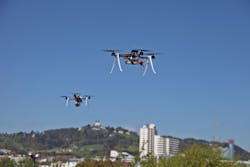FAA Bill Has Focus on Drones, Calls for Extensive Collision Testing
The Federal Aviation Administration (FAA)'s Reauthorization Bill, known at the FAA Extension, Safety, and Security Act of 2016, which recently passed through the Senate and the House, outlined a whole section on unmanned aircraft system (UAS) safety.
There's no doubt that drones are increasing in popularity, and, from the looks of the attention unmanned aircraft gets in this bill, the FAA will need go full throttle into developing new programs and regulations to keep up with it.
A pilot program, for example, will be established to mitigate threats and hazards from an "errant or hostile" unmanned aircraft that could interfere with safe operations of airports and airspace. The program is authorized to use $6,000,000 from the Airport and Airway Trust Fund.
Another program, that seems to focus on defense, safety and exploring the unknown, is the NASA partnership to develop a drone-collision program. The program would have NASA and the FAA testing different sizes and types of drones colliding with a variety of aircraft in different settings. The tests would include collisions with jets, propeller-driven aircraft and rotorcraft, having the unmanned aircraft hitting windshields, noses, engines, radomes, propellers and wings of the aircraft. The cost for this program will be summarized within a year.
But before drones can really have any practical, wide-spread use like many companies and hobbyist foresee, there needs to be a dependable traffic management system in place – something the FAA wants developing right away, according to the bill.
Together with NASA, the FAA will continue to develop a research and deployment plan for a traffic management system (UTM), and it must be completed in about six months, where the plan will then be submitted to members of the Senate and the House, and posted on the FAA website.
From there, the UTM system will go into a pilot program, which will last no more than two years, before, ideally, being implemented.
The FAA previously reported there were 145,000 more registered drone owners in the U.S. than any other aircraft owners, and with so many users, the FAA hopes to develop standards within the year on how to identify and classify different types of drones, as well as consider the feasibility to develop and operate a public online database of operators.
"This FAA extension will provide short-term stability for the commercial UAS industry," Brian Wynne, president and CEO of the Association for Unmanned Vehicle Systems International (AUVSI), said in a news release. "Its provisions will help expand commercial operations, advance research and keep the airspace safe for all users — manned and unmanned."
Drones sales have triple in the last year to about $200 million, according to a retail research firm, NPD, and the new bill would require manufacturers to now provide information about, and source of, law and regulations which apply to products should. The information would also include usage recommendations.
Unmanned aircraft are usually bad news around airports, with drone strikes on the radar. For example, the drone at Dubai International Airport that shutdown operations for more than an hour and caused a 22-flight delay. But, it's not all bad news. Unmanned aircraft are used from anything from firefighting and disaster operations, to faster airplane inspections.
The FAA will enter into agreements with agencies in support of firefighting operations and utility restoration efforts, but outlines a civil penalty of up to $20,000 for any individuals interfering with wildfire suppression, law enforcement or emergency response efforts without permission to do so.
There will also be a emergency exemption process for users, which allows drone owners to apply for a waiver, to use drones to assist with emergency response operations (firefighting, search and rescue, and utility and infrastructure restore efforts.)
To petition the FAA to prohibit or restrict drone operations in close proximity to infrastructures such as energy production, transmission and distribution facilities, oil refineries, chemical facilities, amusement parks, and other locations, the Sectary of Transportation will establish a process.
About the Author
Vesna Brajkovic
Vesna Brajkovic, who grew up around pilots and aviation mechanics, creates digital content for AviationPros.com. She recently graduated from the University of Wisconsin-Whitewater. When she's not writing about the aviation industry, you can find her freelancing for MyCommunityNow-Lake Country (USA Today Network). She can be reached at [email protected].
